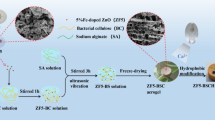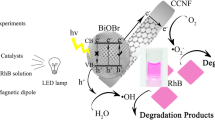Abstract
Bacterial cellulose (BC) is a unique nanofibrous biomaterial, and crystalline cadmium sulphide (CdS) is regarded as one of the most attractive visible light-driven photocatalysts. In this study, a BC@CdS nanocomposite for photocatalytic degradation of organic dye methylene blue (MB) was prepared with a facile and highly efficient strategy. The nanocomposite was prepared through a designed “anchoring-reacting-forming” pathway. SEM images showed that the BC-alcogel was the best matrix for nano-fabrication on which nanosized CdS particles were homogeneously distributed (approximately 100 nm). The results from FT-IR, XRD and XPS revealed that the CdS nanoparticles, mainly cubic and hexagonal crystallite, are attached to the BC fibers via coordination effect. The BC-supported adsorbent photocatalytic material was easy to be recycled and followed a new “adsorption–accumulation–degradation” mechanism of photocatalytic degradation. The results showed BC matrix had a strong adsorption effect on MB molecules, which improved local concentration of MB and promoted the rate of photocatalytic reaction. This novel adsorbent photocatalytic nanocomposite material (contained 12.4% CdS, about 0.91 mg for degradation experiment) possessed highly efficient photocatalytic activity with 77.39% removal of MB after 180 min visible light irradiation (the degradation rate was 28.3% mg−1 h−1), and exhibited satisfactory cyclic utilization with slight attenuation. Therefore, BC@CdS nanocomposite is a novel promising candidate as adsorbent photocatalysts with visible light response.
Graphic abstract









Similar content being viewed by others
References
Auta M, Hameed BH (2014) Chitosan-clay composite as highly effective and low-cost adsorbent for batch and fixed-bed adsorption of methylene blue. Chem Eng J 237:352–361. https://doi.org/10.1016/j.cej.2013.09.066
Bera R, Kundu S, Patra A (2015) 2D hybrid nanostructure of reduced graphene oxide–CdS nanosheet for enhanced photocatalysis. ACS Appl Mater Interfaces 7(24):13251–13259. https://doi.org/10.1021/acsami.5b03800
Bharti DB, Bharati AV, Wankhade AV (2018) Synthesis, characterization and optical property investigation of CdS nanoparticles. Luminescence 33(8):1445–1449. https://doi.org/10.1002/bio.3572
Cao BL, Jiang Y, Wang C, Wang WH, Wang LZ, Niu M (2010) Synthesis and lasing properties of highly ordered CdS nanowire arrays. Adv Func Mater 17(9):1501–1506. https://doi.org/10.1002/adfm.200601179
Chaiyasat A, Jearanai S, Christopher LP, Alam MN (2019) Novel superadsorbent materials from bacterial cellulose. Polym Int 68(1):102–109. https://doi.org/10.1002/pi.5701
Chen S, Zou Y, Yan Z, Shen W, Shi S, Zhang X, Wang H (2009) Carboxymethylated-bacterial cellulose for copper and lead ion removal. J Hazard Mater 161(2–3):1355–1359. https://doi.org/10.1016/j.jhazmat.2008.04.098
Chen X, Song XX, Sun Y (2016) Attapulgite nanofiber-cellulose nanocomposite with core-shell structure for dye adsorption. Int J Polym Sci 2016:1–9. https://doi.org/10.1155/2016/2081734
Chen W, Wu W, Yang W, Zhao J, Xiao M, Kong W (2018) CdCl2-assisting heat-treatment: enhanced photoelectrocatalytic hydrogen generation and stability of CdS/ZnO nanoheterojunction arrays. Int J Hydrog Energy 43(21):9969–9977. https://doi.org/10.1016/j.ijhydene.2018.04.045
Chen XY, Chen C, Zhu J (2019) Facile preparation of cellulose attapulgite nanocomposite hydrogel for dye adsorption. Iran Polym J 28(4):347–359. https://doi.org/10.1007/s13726-019-00703-9
Cheng H, Feng Q, Liao C, Liu Y, Wu D, Wang Q (2016) Removal of methylene blue with hemicellulose/clay hybrid hydrogels. Chin J Polym Sci 34(6):709–719. https://doi.org/10.1007/s10118-016-1788-2
Drachuk I, Harbaugh S, Geryak R, Kaplan DL, Tsukruk VV, Kelley-Loughnane N (2017) Immobilization of recombinant E. coli cells in a bacterial cellulose-silk composite matrix to preserve biological function. ACS Biomater Sci Eng 3(10):2278–2292. https://doi.org/10.1021/acsbiomaterials.7b00367
Duan C, Meng X, Liu C, Lu W, Liu J, Dai L, Wang W, Zhao W, Xiong C, Ni Y (2019) Carbohydrates-rich corncobs supported metal-organic frameworks as versatile biosorbents for dye removal and microbial inactivation. Carbohydr Polym 222:115042. https://doi.org/10.1016/j.carbpol.2019.115042
Dukovic G, Merkle MG, Nelson JH, Hughes SM, Alivisatos AP (2010) Photodeposition of Pt on colloidal CdS and CdSe/CdS semiconductor nanostructures. Adv Mater 20(22):4306–4311. https://doi.org/10.1002/adma.200800384
Fujishima A, Honda K (1972) Electrochemical photolysis of water at a semiconductor electrode. Nature 238(5358):37–38. https://doi.org/10.1038/238037a0
French AD (2014) Idealized powder diffraction patterns for cellulose polymorphs. Cellulose 21(2):885–896. https://doi.org/10.1007/s10570-013-0030-4
Guo L, Li G, Liu J, Meng Y, Tang Y (2013) Adsorptive decolorization of methylene blue by crosslinked porous starch. Carbohydr Polym 93(2):374–379. https://doi.org/10.1016/j.carbpol.2012.12.019
Hernández-Gordillo A, Romero AG, Tzompantzi F, Gómez R (2013) New nanostructured CdS fibers for the photocatalytic reduction of 4-nitrophenol. Powder Technol 250:97–102. https://doi.org/10.1016/j.powtec.2013.10.008
Jung YH, Chang TH, Zhang H, Yao C, Zheng Q, Yang VW (2015) High-performance green flexible electronics based on biodegradable cellulose nanofibril paper. Nat Commun 6:1–11. https://doi.org/10.1038/ncomms8170
Kashcheyeva EI, Gladysheva EK, Skiba EA, Budaeva VV (2019) A study of properties and enzymatic hydrolysis of bacterial cellulose. Cellulose 26(4):2255–2265. https://doi.org/10.1007/s10570-018-02242-7
Lai S, Chang X, Fu C (2009) Cadmium sulfide quantum dots modified by chitosan as fluorescence probe for copper(II) ion determination. Microchim Acta 165(1–2):39–44. https://doi.org/10.1007/s00604-008-0094-2
Li X, Chen S, Hu W, Shi S, Shen W, Zhang X, Wang H (2009) In situ synthesis of CdS nanoparticles on bacterial cellulose nanofibers. Carbohydr Polym 76(4):509–512. https://doi.org/10.1016/j.carbpol.2008.11.014
Li J, Cao J, Zhang X, Wang S, Zheng Y, Pan J, Li C (2016) Preparation of cotton cellulose nanofibers/ZnO/CdS nanocomposites and its photocatalytic activity. J Mater Sci 27(2):1479–1484. https://doi.org/10.1007/s10854-015-3914-2
Liang H, Angelini TE, Braun PV, Wong GCL (2004) Roles of anionic and cationic template components in biomineralization of CdS nanorods using self-assembled DNA-membrane complexes. J Am Chem Soc 126(43):14157–14165. https://doi.org/10.1021/ja046718m
Liu Y, Zheng YA, Wang AQ (2010) Enhanced adsorption of methylene blue from aqueous solution by chitosan-g-poly (acrylic acid)/vermiculite hydrogel composites. J Environ Sci 22(4):486–493. https://doi.org/10.1016/S1001-0742(09)60134-0
Liu Y, Ma YJ, Liu WW, Shang YY, Zhu AQ, Tan PF (2017) Facet and morphology dependent photocatalytic hydrogen evolution with CdS nanoflowers using a novel mixed solvothermal strategy. J Colloid Interface Sci 513:222–230. https://doi.org/10.1016/j.jcis.2017.11.030
Maghsoudi-Ganjeh M, Lin LQ, Wang XD (2019) Bioinspired design of hybrid composite materials. Int J Smart Nano Mater 10(1):90–105. https://doi.org/10.1080/19475411.2018.1541145
Meng AY, Zhu BC, Zhong B, Zhang LY, Cheng B (2017) Direct Z-scheme TiO2/CdS hierarchical photocatalyst for enhanced photocatalytic H2-production activity. Appl Surf Sci 422:518–527. https://doi.org/10.1016/j.a[sisc/2017.06.028
Qi LM, Cölfen H, Antonietti M (2000) Synthesis and characterization of CdS nanoparticles stabilized by double-hydrophilic block copolymers. Nano Lett 1(2):61–65. https://doi.org/10.1021/nl0055052
Qiu K, Netravali AN (2014) A review of fabrication and applications of bacterial cellulose based nanocomposites. Polym Rev 54(4):598–626. https://doi.org/10.1080/15583724.2014.896018
Rehman MSU, Kim I, Han J-I (2012) Adsorption of methylene blue dye from aqueous solution by sugar extracted spent rice biomass. Carbohydr Polym 90(3):1314–1322. https://doi.org/10.1016/j.carbpol.2012.06.078
Shi J, Qin Y, Wu W, Li X, Guo ZX, Zhu D (2004) In situ synthesis of CdS nanoparticles on multi-walled carbon nanotubes. Carbon 42(2):455–458. https://doi.org/10.1016/j.carbon.2003.11.016
Shim I-W, Noh W-T, Kwon J, Cho JY, Kim K-S, Kang D-H (2002) Preparation of copper nanoparticles in cellulose acetate polymer and the reaction chemistry of copper complexes in the polymer. Bull Korean Chem Soc 23(4):563–566. https://doi.org/10.5012/bkcs.2002.23.4.563
Venkatareddy C, Bandaru N, Reddy IN, Shim J, Yoo K (2018) UV–Visible light driven photocatalytic activities of CdS nanoparticles supported ZnO layers. Mater Sci Eng B 232:68–75. https://doi.org/10.1016/j.mseb.2018.11.004
Wang SM, Liu P, Wang XX, Fu X (2005) Homogeneously distributed CdS nanoparticles in nafion membranes: preparation, characterization, and photocatalytic properties. Langmuir ACS J Surf Colloids 21(25):11969–11973. https://doi.org/10.1021/la051072c
Wang HJ, Cao Y, Wu LL, Wu SS, Raza A, Liu N (2018) ZnS-based dual nano-semiconductors (ZnS/PbS, ZnS/CdS or ZnS/Ag2S,): A green synthesis route and photocatalytic comparison for removing organic dyes. J Environ Chem Eng 6(6):6771–6779. https://doi.org/10.1016/j.jece.2018.10.034
Wang J, Tavakoli J, Tang Y (2019) Bacterial cellulose production, properties and applications with different culture methods: a review. Carbohyd Polym 219:63–76. https://doi.org/10.1016/j.carbpol.2019.05.008
Wei LC, Luo JX, Jiang LJ, Qiu LJ, Zhang JM, Zhang DW (2018) CoSe2 nanoparticles grown on carbon nanofibers derived from bacterial cellulose as an efficient electrocatalyst for hydrogen evolution reaction. Int J Hydrog Energy 43(45):20704–20711. https://doi.org/10.1016/j.ijhydene.2018.09.151
Xiong SL, Zhang XG, Qian YT (2009) CdS with various novel hierarchical nanostructures by nanobelts/nanowires self-assembly: controllable preparation and their optical properties. Cryst Growth Des 9(12):5259–5265. https://doi.org/10.1021/cg900780a
Yang J, Wang D, Han H, Li C (2013) Roles of cocatalysts in photocatalysis and photoelectrocatalysis. Acc Chem Res 46(8):1900–1909. https://doi.org/10.1021/ar300227e
Zeng JH, Yu Z, Liu YF, Jian Y, Qian YT, Zheng HG (2002) Morphology development of CdS/PVAc composite from spheres to rods. Mater Sci Eng B 94(2–3):131–135. https://doi.org/10.1016/S0921-5107(01)00945-X
Zhai TY, Fang XS, Bando Y, Liao Q, Xu XJ, Zeng HB (2009) Morphology-dependent stimulated emission and field emission of ordered CdS nanostructure arrays. ACS Nano 3(4):949–959. https://doi.org/10.1021/nn800895k
Zhang BX, Yu H, Zhang YB, Luo ZH, Han WJ, Qiu WF, Zhao T (2018) Bacterial cellulose derived monolithic titania aerogel consisting of 3D reticulate titania nanofibers. Cellulose 25(12):7189–7196. https://doi.org/10.1007/s10570-018-2073-z
Zhou Y, Ji Q, Masuda M, Kamiya S, Shimizu T (2006) Helical arrays of CdS nanoparticles tracing on a functionalized chiral template of glycolipid nanotubes. Chem Mater A 18(2):403–406. https://doi.org/10.1021/cm051928z
Zhou M, Chen JW, Hou CJ, Liu YJ, Xu S, Yao C, Li ZY (2019) Organic-free synthesis of porous CdS sheets with controlled windows size on bacterial cellulose for photocatalytic degradation and H2 production. Appl Surf Sci 470:908–916. https://doi.org/10.1016/j.apsusc.2018.11.207
Zhu Y, Wang Y, Zhi C, Qin L, Yang L, Liang Z (2015) Visible light induced photocatalysis on CdS quantum dots decorated TiO2 nanotube arrays. Appl Catal A 498:159–166. https://doi.org/10.1016/j.apcata.2015.03.035
Acknowledgments
The authors gratefully acknowledge the High-level Foreign Experts Project (GDT20186100425), and the Shaanxi University of Science and Technology Academic Leader Training Program (2013XSD25).
Author information
Authors and Affiliations
Corresponding authors
Ethics declarations
Conflict of interest
The authors declare that there are no conflicts of interest.
Additional information
Publisher's Note
Springer Nature remains neutral with regard to jurisdictional claims in published maps and institutional affiliations.
Electronic supplementary material
Below is the link to the electronic supplementary material.
Rights and permissions
About this article
Cite this article
Qian, X., Xu, Y., Yue, X. et al. Microwave-assisted solvothermal in-situ synthesis of CdS nanoparticles on bacterial cellulose matrix for photocatalytic application. Cellulose 27, 5939–5954 (2020). https://doi.org/10.1007/s10570-020-03196-5
Received:
Accepted:
Published:
Issue Date:
DOI: https://doi.org/10.1007/s10570-020-03196-5




